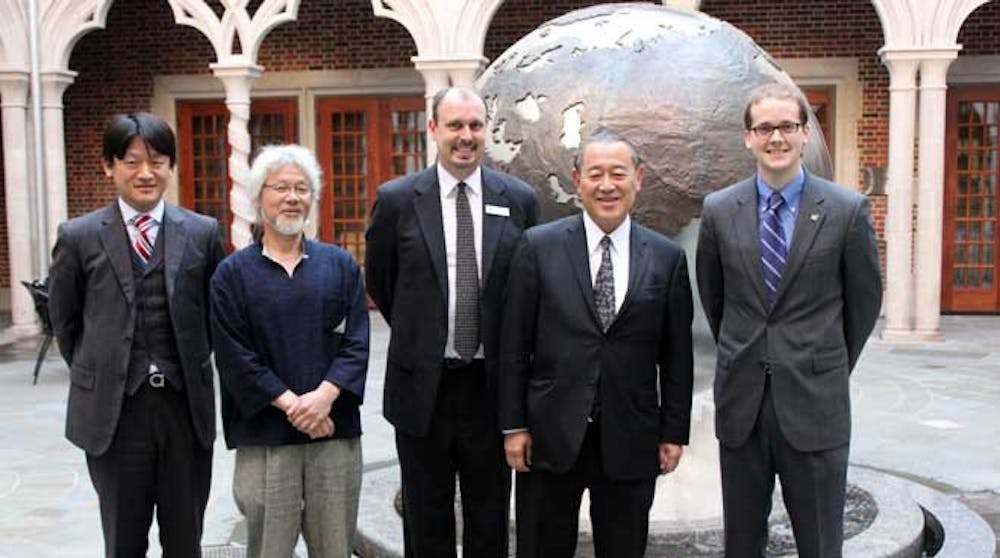Students, faculty and members of the Richmond community filed into the International Center Commons March 13 to witness the Ambassador of Japan to the United States give his opening remarks in remembrance of Japan's 2011 earthquake and tsunami.
Ambassador Ichiro Fujisaki joined several panelists at Japan's Earthquake: A Year in Review, a gathering to remember the events of last year's March 11 disaster and to commemorate the progress Japan has made since.
Other panelists included Scott Allison, University of Richmond professor of psychology, Andy Anderson, founder of the Taylor Anderson Memorial Gift Fund, Nancy Bagranoff, dean of the Robins School of Business, Martin Chapman, Virginia Tech research associate professor of geophysics, and Vincent Wei-cheng Wang, University of Richmond professor of political science.
Wesley Julian, University of Richmond graduate student and media relations coordinator at the Consulate General of Japan in Chicago, was the driving force behind this commemoration that began taking shape in the fall of 2011.
"In March, I experienced the great east Japan earthquake firsthand in Miyagi Prefecture," Julian said. "In June, I volunteered in Tokyo and Ishinomaki, Miyagi, and in August, I represented the Japanese Ministry of Foreign Affairs through the Tohoku Invitation Program, a grassroots public relations campaign."
By the time he was back at the University of Richmond in the fall, he had wanted to organize something that would allow him to share his experiences with the community, he said.
More than 115 students, faculty, staff and greater Richmond community members were in attendance, many staying throughout the program, said Katreena Clark, events and publications coordinator for the Office of International Education. Clark worked alongside Julian in the planning of the panel.
"Throughout the evening, panelists referred to each other's areas of expertise, further demonstrating the value of collaborative work among multiple disciplines," she said. "I believe the audience left with a much better understanding of the state of Japan, the many challenges its citizens continue to face and the progress the country has made since March 11, 2011."
In his opening remarks, the ambassador brought attention to the Taylor Anderson Fund and the Anderson family.
"Last year, [Anderson's] daughter, and my friend, Taylor, passed away in the tsunami," Julian said. "However, the Anderson family has taken it upon themselves to carry out Taylor's dream of connecting Japan and the United States. They have established a foundation in her honor and have raised funds to support Ishinomaki City and the affected."
Fujisaki expressed his gratitude to the Anderson family for Taylor's accomplishments. Everyone has their destiny, he told the audience, and even though her life was short, she accomplished her mission. He said she had wanted to be a good teacher and a bridge between Japan and America, and she had done it.
"I was very impressed about [Ambassador Fujisaki's] candor and feelings around the Taylor Anderson story," said Joe Hoff, Associate Dean of International Education. "You could tell that he was moved by the story and his subsequent involvement with Taylor's family."
Enjoy what you're reading?
Signup for our newsletter
Following Fujisaki's remarks, each panelist educated the audience on different aspects of the earthquake and its aftermath through short presentations.
The audience had an opportunity to explore the geographic, economic, political and psychological ramifications of the Tohoku earthquake from an interdisciplinary perspective, Clark said.
"While Ambassador Fujisaki departed earlier than expected, we are honored that he made time in his schedule to visit the university and address the audience," she said.
Anderson gave the closing remarks, highlighting the success of Taylor's fund. The Anderson family had traveled to Japan to establish the Taylor Anderson Reading Corners, also known as Taylor Bunko, he said. The unique aspect of each Taylor Bunko was that it had 60 of Taylor's favorite children's books along with 200 other selected books.
These reading corners were set up in several schools in Ishinomaki where Taylor had previously taught English for the Japan Exchange and Teaching program.
"The response of the Japanese and the international community was a shining example of how to handle a major disaster," Julian said. "From people capturing personal video to the countless points of scientific data, the disaster offers a large recording of data that could help prevent or reduce the devastation of future events."
Julian said he expected the audience to walk away with an accurate and academically sound understanding of Japan's current situation.
"It is my hope that everyone will leave the event knowing that Japan is safe, resilient and on the road towards reconstruction," he said.
Contact reporter Sheetal Babu at sheetal.babu@richmond.edu
Support independent student media
You can make a tax-deductible donation by clicking the button below, which takes you to our secure PayPal account. The page is set up to receive contributions in whatever amount you designate. We look forward to using the money we raise to further our mission of providing honest and accurate information to students, faculty, staff, alumni and others in the general public.
Donate Now



